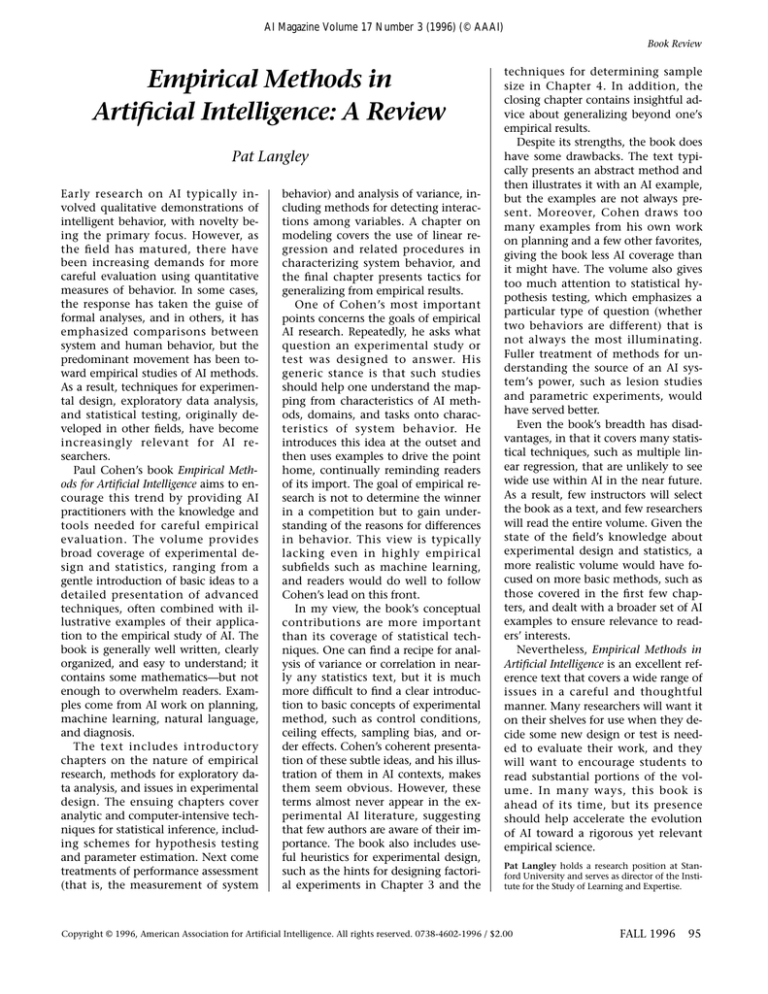
AI Magazine Volume 17 Number 3 (1996) (© AAAI)
Book Review
Empirical Methods in
Artificial Intelligence: A Review
Pat Langley
Early research on AI typically involved qualitative demonstrations of
intelligent behavior, with novelty being the primary focus. However, as
the field has matured, there have
been increasing demands for more
careful evaluation using quantitative
measures of behavior. In some cases,
the response has taken the guise of
formal analyses, and in others, it has
emphasized comparisons between
system and human behavior, but the
predominant movement has been toward empirical studies of AI methods.
As a result, techniques for experimental design, exploratory data analysis,
and statistical testing, originally developed in other fields, have become
increasingly relevant for AI researchers.
Paul Cohen’s book Empirical Methods for Artificial Intelligence aims to encourage this trend by providing AI
practitioners with the knowledge and
tools needed for careful empirical
evaluation. The volume provides
broad coverage of experimental design and statistics, ranging from a
gentle introduction of basic ideas to a
detailed presentation of advanced
techniques, often combined with illustrative examples of their application to the empirical study of AI. The
book is generally well written, clearly
organized, and easy to understand; it
contains some mathematics—but not
enough to overwhelm readers. Examples come from AI work on planning,
machine learning, natural language,
and diagnosis.
The text includes introductory
chapters on the nature of empirical
research, methods for exploratory data analysis, and issues in experimental
design. The ensuing chapters cover
analytic and computer-intensive techniques for statistical inference, including schemes for hypothesis testing
and parameter estimation. Next come
treatments of performance assessment
(that is, the measurement of system
behavior) and analysis of variance, including methods for detecting interactions among variables. A chapter on
modeling covers the use of linear regression and related procedures in
characterizing system behavior, and
the final chapter presents tactics for
generalizing from empirical results.
One of Cohen’s most important
points concerns the goals of empirical
AI research. Repeatedly, he asks what
question an experimental study or
test was designed to answer. His
generic stance is that such studies
should help one understand the mapping from characteristics of AI methods, domains, and tasks onto characteristics of system behavior. He
introduces this idea at the outset and
then uses examples to drive the point
home, continually reminding readers
of its import. The goal of empirical research is not to determine the winner
in a competition but to gain understanding of the reasons for differences
in behavior. This view is typically
lacking even in highly empirical
subfields such as machine learning,
and readers would do well to follow
Cohen’s lead on this front.
In my view, the book’s conceptual
contributions are more important
than its coverage of statistical techniques. One can find a recipe for analysis of variance or correlation in nearly any statistics text, but it is much
more difficult to find a clear introduction to basic concepts of experimental
method, such as control conditions,
ceiling effects, sampling bias, and order effects. Cohen’s coherent presentation of these subtle ideas, and his illustration of them in AI contexts, makes
them seem obvious. However, these
terms almost never appear in the experimental AI literature, suggesting
that few authors are aware of their importance. The book also includes useful heuristics for experimental design,
such as the hints for designing factorial experiments in Chapter 3 and the
techniques for determining sample
size in Chapter 4. In addition, the
closing chapter contains insightful advice about generalizing beyond one’s
empirical results.
Despite its strengths, the book does
have some drawbacks. The text typically presents an abstract method and
then illustrates it with an AI example,
but the examples are not always present. Moreover, Cohen draws too
many examples from his own work
on planning and a few other favorites,
giving the book less AI coverage than
it might have. The volume also gives
too much attention to statistical hypothesis testing, which emphasizes a
particular type of question (whether
two behaviors are different) that is
not always the most illuminating.
Fuller treatment of methods for understanding the source of an AI system’s power, such as lesion studies
and parametric experiments, would
have served better.
Even the book’s breadth has disadvantages, in that it covers many statistical techniques, such as multiple linear regression, that are unlikely to see
wide use within AI in the near future.
As a result, few instructors will select
the book as a text, and few researchers
will read the entire volume. Given the
state of the field’s knowledge about
experimental design and statistics, a
more realistic volume would have focused on more basic methods, such as
those covered in the first few chapters, and dealt with a broader set of AI
examples to ensure relevance to readers’ interests.
Nevertheless, Empirical Methods in
Artificial Intelligence is an excellent reference text that covers a wide range of
issues in a careful and thoughtful
manner. Many researchers will want it
on their shelves for use when they decide some new design or test is needed to evaluate their work, and they
will want to encourage students to
read substantial portions of the volume. In many ways, this book is
ahead of its time, but its presence
should help accelerate the evolution
of AI toward a rigorous yet relevant
empirical science.
Pat Langley holds a research position at Stanford University and serves as director of the Institute for the Study of Learning and Expertise.
Copyright © 1996, American Association for Artificial Intelligence. All rights reserved. 0738-4602-1996 / $2.00
FALL 1996
95







